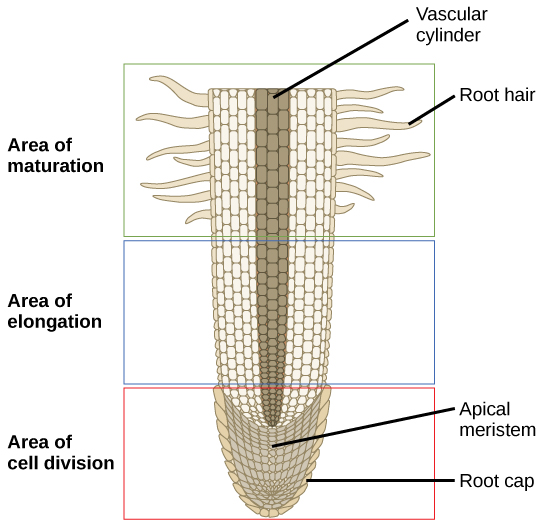30.6: Roots - Types of Root Systems and Zones of Growth
- Page ID
- 13750
- Describe the three zones of the root tip and summarize the role of each zone in root growth
Types of Root Systems
There are two main types of root systems. Dicots have a tap root system, while monocots have a fibrous root system, which is also known as an adventitious root system. A tap root system has a main root that grows down vertically, from which many smaller lateral roots arise. Dandelions are a common example; their tap roots usually break off when these weeds are pulled from the ground; they can regrow another shoot from the remaining root. A tap root system penetrates deep into the soil. In contrast, a fibrous root system is located closer to the soil surface where it forms a dense network of roots that also helps prevent soil erosion (lawn grasses are a good example, as are wheat, rice, and corn). Some plants have a combination of tap roots and fibrous roots. Plants that grow in dry areas often have deep root systems, whereas plants that grow in areas with abundant water are likely to have shallower root systems.

Zones of the Root Tip
Root growth begins with seed germination. When the plant embryo emerges from the seed, the radicle of the embryo forms the root system. The tip of the root is protected by the root cap, a structure exclusive to roots and unlike any other plant structure. The root cap is continuously replaced because it is easily damaged as the root pushes through soil. The root tip can be divided into three zones: a zone of cell division, a zone of elongation, and a zone of maturation. The zone of cell division is closest to the root tip and is made up of the actively-dividing cells of the root meristem, which contains the undifferentiated cells of the germinating plant. The zone of elongation is where the newly-formed cells increase in length, thereby lengthening the root. Beginning at the first root hair is the zone of cell maturation where the root cells differentiate into specialized cell types. All three zones are in approximately the first centimeter of the root tip.

Key Points
- Root tips ultimately develop into two main types of root systems: tap roots and fibrous roots.
- The growing root tip is protected by a root cap.
- Within the root tip, cells differentiate, actively divide, and increase in length, depending on in which zone the cells are located.
- Dividing cells make up the zone of cell division in a germinating plant.
- The newly-forming root increases in size in the zone of elongation.
- Differentiating cells make up the zone of cell maturation.
Key Terms
- radicle: the rudimentary shoot of a plant that supports the cotyledons in the seed and from which the root is developed downward; the root of the embryo
- meristem: the plant tissue composed of totipotent cells that allows plant growth
- germination: the beginning of vegetation or growth from a seed or spore


